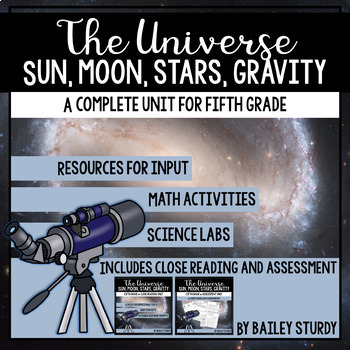5th Grade NGSS™ Astronomy and Space Unit
- Zip
Also included in
- This bundle includes all 4 units for 5th grade: Earth's Spheres, Ecosystems, Astronomy & Universe, and Matter.In this bundle you will find:Resources for InputInquiry ChartObservation ChartsBig Book (PPT or printable)Pictorial and Comparative Input Chart templates (16 total)Brightest Stars in thePrice $44.80Original Price $57.00Save $12.20
Description
This is a complete unit for 5th grade, covering NGSS standards about stars, the sun and moon, and gravity. It integrates reading, writing, math, art, and of course, science!
What's Included?
RESOURCES FOR INPUT
- Unit Essential Question
- Inquiry Chart Templates (2)
- Observation Chart Photos
- Cognitive Content Dictionary Template
- Astronomy Big Book
- PowerPoint version of the Big Book
- Super Scientist Awards
- 3 Pictorial or Comparative Input Charts with Demo Activities. Titles are:
- Relationships Between the Earth, Sun, and Moon
- Brightest Stars in the Night Sky
- Gravitational Force
- 2 Chants
- 3 Sentence Pattern Chart Templates
- Planets Expert Groups (Set of 8) with Mind Map, Process Grid and Photos
- Patterns in the Sky Expert Groups (Set of 6) with Mind Map, Process Grid, and Photos
- 3 Writing Prompts
MATH INTEGRATION
5 activities. Titles are:
- Race Through the Stars (Rounding Decimals game)
- Celestial Objects Exponents (center/station activity)
- Multiplying Fractions (center/station activity)
- Rocket Expressions (puzzles)
- Coordinate Plane Printables
SCIENCE LABS
5 labs/activities/engineering challenge. Titles are:
- Shadow Graphing
- Build a Sundial
- Graphs and Models of Observable Patterns
- Planisphere
- Marble Run Design Challenge
ART INTEGRATION
- Printables of 6 works of art
- Guiding Questions for the art works to connect art and science
- 1 Art Lesson
CLOSE READING
NOTE: This unit INCLUDES the 5th Grade Astronomy Close Reading Packet. There is no need to buy both the unit and the close reading packet.
- Three sets of paired texts (6 texts in all)
- 9 Question Sets
- 6 Extended Response Prompts
- Answer Keys for the Question Sets ONLY
Each of the texts is available at a beginning, middle, and end of fifth grade reading level, and in either article or reader format.
Google Slides™ versions of the text sets are also included!
Titles of the texts are:
- Twinkle, Twinkle
- Star Light, Star Bright
- Copernicus
- Galileo
- To Infinity!
- Race From Space
ASSESSMENT
NOTE: This assessment is also available separately here. There is no need to buy both the unit and the assessment, as the assessment is INCLUDED in this unit.
- 1 Assessment (22 questions) with Answer Key






